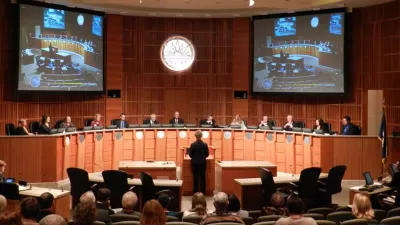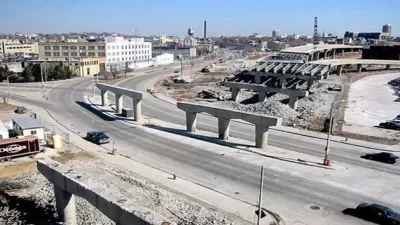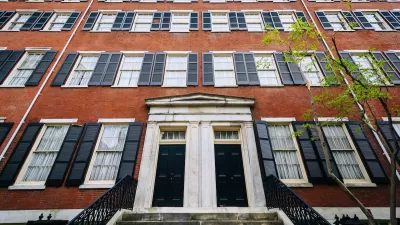What is the highest purpose of community engagement? Why do some planners go all out to hear from the public? This article dives into these questions based on nine interviews conducted at APA 2016.

Community engagement is a required component of planning projects. Some planners take a "check the box" approach and others go out of their way to hear from the public. I was curious what motivates planners to go the extra distance on outreach so I did an informal survey at the American Planning Association National Conference. The most common answer surprised me. They said some version of, "It gave courage to our elected officials." There’s a great deal of insight packed into this answer.
At the APA 2016, I conducted nine interviews with planners who were being celebrated for excellence in community engagement. I didn’t set out to conduct a scientific survey. I was creating a marketing video of interviews with planners who used our community engagement software. In looking through the program, there were 11 presenters and two award recipients to track down. I caught up with nine of them making for nice, albeit unscientific, set of interviews.
I say unscientific because this was a rather small sample. They all used MetroQuest as a part of their community engagement effort, and they were selected because they happened to be presenting at the APA conference. They did have one thing in common: they clearly felt that community engagement was a high priority. At the end of each interview, after all the project related questions, I threw in a question for my own curiosity. I asked, “Why?”
All of these planners went above and beyond in the area of community engagement for their planning projects. Quite separate from how they did it, I was curious about why. I really wanted to know what difference it made. Why bother?
This question made people pause. After a moment of reflection, the most common answer surprised me. I was expecting people to talk about democracy, transparency, and listening to residents. While these goals were certainly part of it, that's not what they talked about. These planners felt that the most significant benefit of outstanding community engagement was that it gave courage to their elected officials. I probed to learn more. What they told me was something that I’ve thought about many times since.
The fact that elected official were a critical audience for the results of community engagement makes sense. After all, these are the people making the community-changing decisions that emerge out of planning projects.
The idea of giving elected officials courage was the interesting part to me. There's so much in that word and when I probed further here is what they said.
A "business as usual" plan doesn’t require nearly as much courage to approve as an ambitious plan calling for dramatic and lasting changes to the community. Deciding to change takes courage. It's as true for people as it is for communities.
I asked about the ingredients of courage. From a community engagement perspective, what does it take to give decision makers courage? Once again the responses formed a consistent pattern. According to the planners interviewed there were three required elements that community engagement must have to provide courage to decision makers:
- Critical mass – Elected officials, at least those interested in being re-elected, are swayed by large numbers. While it can be easy to disregard the input of a small group of usual suspects, it's quite another thing to disregard the input of thousands of engaged citizens especially when they are calling for change. Essentially elected officials are asking, "Will approving this plan make me more or less popular with voters."
- Diversity – Large numbers of participants are much more persuasive if you can also demonstrate that the participation was diverse. Diversity includes race, ethnicity, socio-economic status, age, physical abilities, and so on. Beyond these categories, the business community, special interest groups, community organizations, and faith-based communities all need a voice. These groups have unique needs and perspectives and can also organize powerful opposition. Essentially elected officials are asking, "Will these groups support the plan?" Or perhaps, "Can I defend the plan in front of these groups?"
- Informed input – I've sat in many council meetings where community engagement results were being presented only to see things grind to a halt when someone criticizes the questions people were asked or the way they were asked. Planning choices can be complex and each option comes with benefits and trade-offs. In order to be confident that people really support the changes being called for, it's critical to be able to make the case that the people who provided input were well aware of both the benefits and costs, especially the costs. It does little to have a "cover your butt" answer. Elected officials don't think like lawyers when it comes to community engagement. The costs and trade-offs can’t be in the fine print. They have to be unmissable. Then, and only then, will they trust that people are willing to make the trade-offs associated with the changes in order to reap the benefits. It's always the trade-offs that make the plan vulnerable to criticism and backlash. Essentially elected officials are asking, "Can I trust this community input?"
As I sifted through all the interview footage these three elements came up repeatedly. It was interesting to me that the emphasis was on creating a defensible case for change. It is a perspective on the role of community engagement that is not discussed frequently. It only emerged when I asked, "Why?"
Since the sample size was small and rather self-selected, I'll end with a question. Does this resonate with you? Is giving courage to elected officials a critical goal of your community engagement. What is your "Why?" Feel free to use the comment section or email, whichever suits you best.

Alabama: Trump Terminates Settlements for Black Communities Harmed By Raw Sewage
Trump deemed the landmark civil rights agreement “illegal DEI and environmental justice policy.”

Planetizen Federal Action Tracker
A weekly monitor of how Trump’s orders and actions are impacting planners and planning in America.

The 120 Year Old Tiny Home Villages That Sheltered San Francisco’s Earthquake Refugees
More than a century ago, San Francisco mobilized to house thousands of residents displaced by the 1906 earthquake. Could their strategy offer a model for the present?

Ken Jennings Launches Transit Web Series
The Jeopardy champ wants you to ride public transit.

BLM To Rescind Public Lands Rule
The change will downgrade conservation, once again putting federal land at risk for mining and other extractive uses.

Indy Neighborhood Group Builds Temporary Multi-Use Path
Community members, aided in part by funding from the city, repurposed a vehicle lane to create a protected bike and pedestrian path for the summer season.
Urban Design for Planners 1: Software Tools
This six-course series explores essential urban design concepts using open source software and equips planners with the tools they need to participate fully in the urban design process.
Planning for Universal Design
Learn the tools for implementing Universal Design in planning regulations.
Clanton & Associates, Inc.
Jessamine County Fiscal Court
Institute for Housing and Urban Development Studies (IHS)
City of Grandview
Harvard GSD Executive Education
Toledo-Lucas County Plan Commissions
Salt Lake City
NYU Wagner Graduate School of Public Service






























